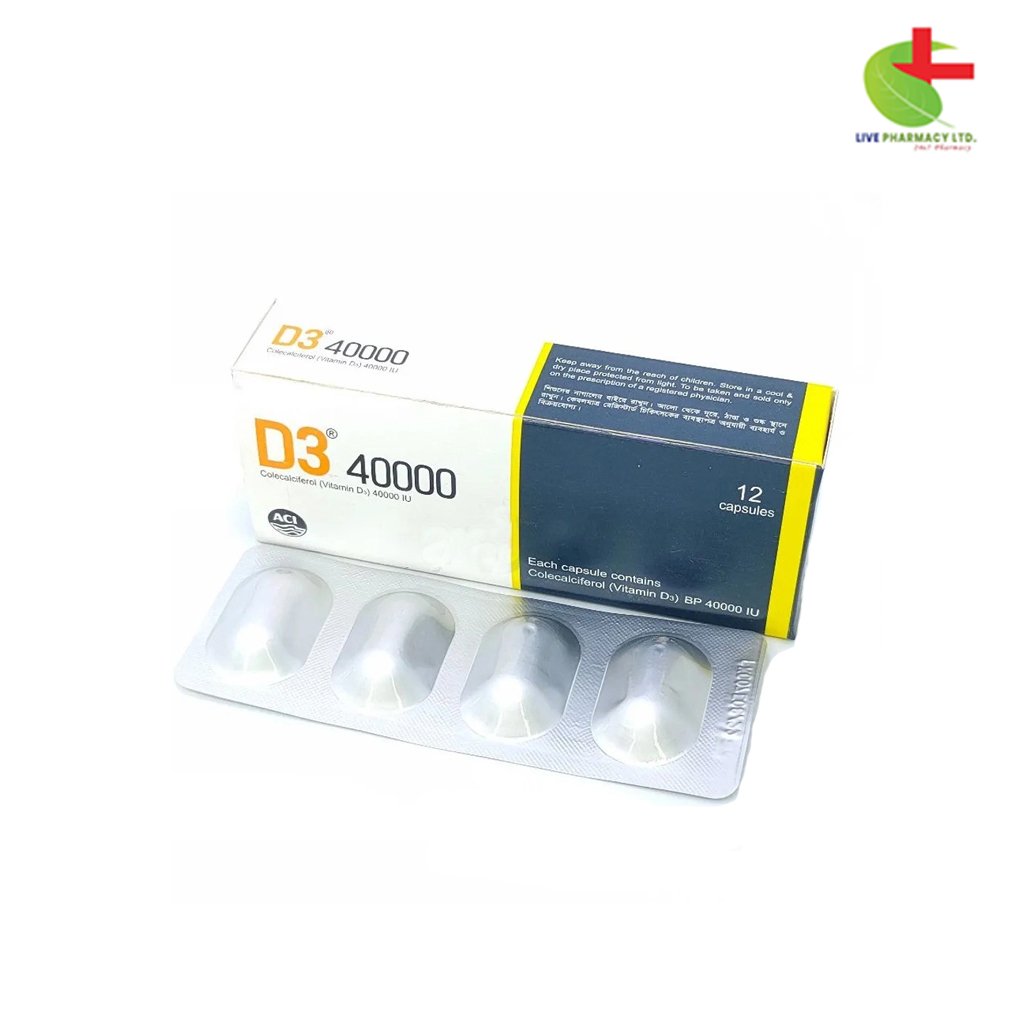D3-40000 IU
140.00৳ Strip
- Essential Vitamin D3 supplements combat deficiencies from limited sunlight and dietary sources.
- Vital for calcium and phosphate absorption, supporting strong bones and teeth.
- Boosts immunity and aids in healthy pregnancy.
- High-quality formulations suitable for all ages.
- Discover the benefits of Vitamin D3 for optimal health and wellness!
 Brand
Brand
|
ACI Limited |
|---|---|
 Generics
Generics
|
Cholecalciferol [Vitamin D3] |
 Type
Type
|
Capsule |
Indications
Vitamin D3 deficiency often arises in individuals with limited sunlight exposure or those with a diet low in vitamin D3. This vital nutrient is crucial for the optimal absorption of calcium and phosphate, which supports healthy bones and teeth, preventing conditions like rickets, osteomalacia, and osteoporosis. Additionally, Vitamin D3 plays an essential role in preventing pre-eclampsia during pregnancy and breastfeeding, as it is a key nutrient for developing infants. It also significantly enhances immune function.
Pharmacology
The active form of Vitamin D3, Calcitriol, functions by binding to Vitamin D receptors (VDRs) found in various tissues throughout the body. Being fat-soluble, Vitamin D3 has a half-life of approximately 50 days. It is absorbed in the small intestine, where it binds to specific alpha-globulins before being transported to the liver for metabolism into 25-hydroxy Vitamin D3 (Calcidiol). A second hydroxylation in the kidneys produces 1,25-dihydroxy Vitamin D3 (Calcitriol), the active metabolite responsible for enhancing calcium absorption. Unmetabolized Vitamin D3 is stored in fat and muscle tissues, with elimination occurring via feces and urine.
Dosage & Administration
For Capsules:
- Adults:
- Deficiency Treatment: 40,000 IU weekly for 7 weeks, followed by a maintenance dose of 1,400–2,000 IU daily. Confirm 25-hydroxyvitamin D levels 3–4 months post-therapy initiation.
- Deficiency Prevention: 20,000 IU every 4 weeks. Higher doses may be necessary in specific cases.
- Osteoporosis Therapy Addition: 20,000 IU once a month.
- Children (12-18 years):
- Deficiency Treatment: 20,000 IU every 2 weeks for 6 weeks.
- Deficiency Prevention: 20,000 IU every 6 weeks.
For Film-Coated Tablets:
- 1,000 IU (1–2 tablets) daily, or as directed by a physician. Take with food or within 1 hour after a meal.
For Chewable Tablets:
- 1,000–2,000 IU daily, or as directed by a physician. Take with food or within 1 hour after a meal. Chew thoroughly before swallowing.
For Syrup:
- At Risk of Cholecalciferol Deficiency:
- 0-1 year: 400 IU/day (2 ml)
-
1 year: 600 IU/day (3 ml)
- For Deficient Patients:
- 0-1 year: 2,000 IU/day (+50,000 IU/week) for 6 weeks
- 1-18 years: 2,000 IU/day for 6 weeks.
Injection:
- Prevention:
- Infants on Vitamin D-enriched milk: ½ ampoule (0.5 ml) or 100,000 IU every 6 months.
- Breastfed infants or those not on enriched milk: 1 ampoule (1 ml) or 200,000 IU every 6 months.
- Adolescents: 1 ampoule (1 ml) or 200,000 IU every 6 months during winter.
- Pregnant women: ½ ampoule (0.5 ml) or 100,000 IU from the 6th or 7th month of pregnancy.
- Elderly: ½ ampoule (0.5 ml) or 100,000 IU every 3 months, or as needed for specific conditions.
Interactions
Several medications can lead to Vitamin D3 deficiencies by affecting its absorption and metabolism. These include magnesium-containing antacids, digoxin, thiazide diuretics, cholestyramine, cholestipol, phenytoin, phenobarbital, orlistat, and mineral oil. Additionally, corticosteroids like prednisolone may increase the requirement for Vitamin D3.
Contraindications
Vitamin D3 should not be used in cases of hypercalcemia or hypersensitivity to Vitamin D3 or its components. It is also contraindicated in individuals with Vitamin D3 toxicity.
Side Effects
Potential side effects are rare but may include loss of appetite, fatigue, nausea, vomiting, diarrhea, constipation, weight loss, increased urination, sweating, headaches, thirst, dizziness, and elevated calcium and phosphate levels in plasma and urine.
Pregnancy & Lactation
Research indicates that doses up to 4,000 IU during pregnancy are safe. The recommended daily intake for pregnant women is 400 IU, though higher doses may be necessary for those deficient. Medical guidance is essential, as requirements may vary based on individual health.
Vitamin D3 and its metabolites are present in breast milk. While overdoses in nursing infants from breastfeeding have not been reported, practitioners should consider the total vitamin D3 intake when prescribing to breastfeeding mothers.
Precautions & Warnings
Monitor plasma calcium levels regularly in patients receiving high doses of Vitamin D3, especially those with renal impairment or during pregnancy and lactation. Individuals taking digoxin or thiazide diuretics should consult a healthcare professional before supplementing with Vitamin D3. Those with liver or kidney diseases, primary hyperthyroidism, lymphoma, tuberculosis, or granulomatous diseases should seek medical advice before using Vitamin D3.
Use in Special Populations
The safety and efficacy of Vitamin D3 in children under 12 years have not been established.
Overdose Effects
Excessive intake can lead to hypervitaminosis D.
Therapeutic Class
Vitamin for bone health; Vitamin D preparations.
Storage Conditions
Store below 30ºC, away from light and moisture. Keep out of reach of children.













Reviews
There are no reviews yet.